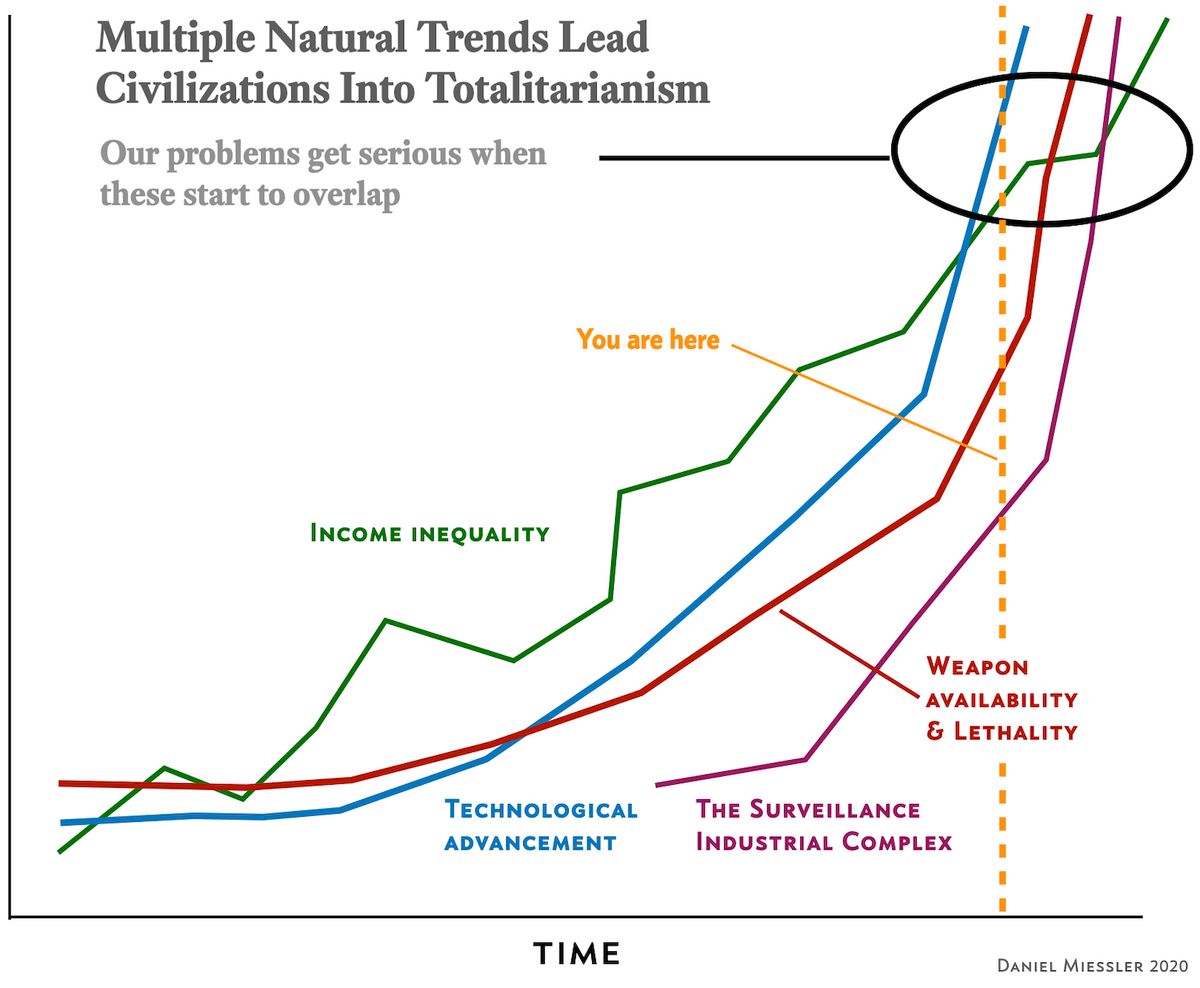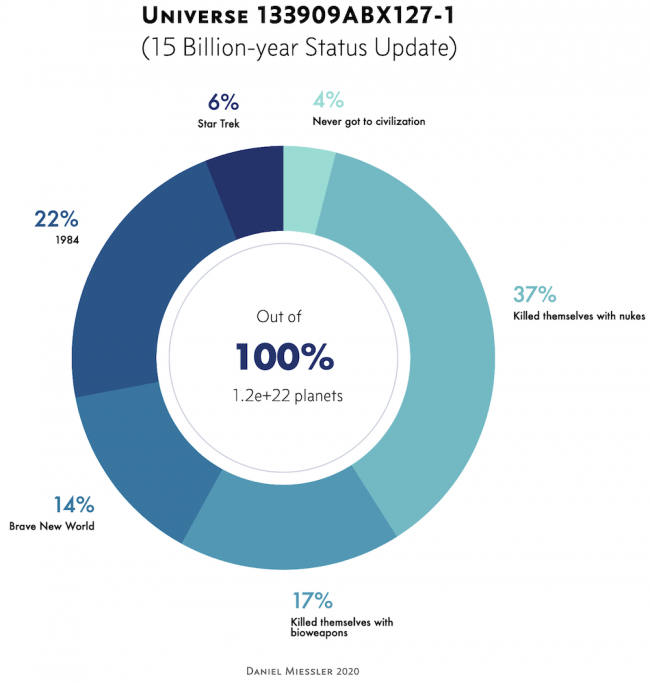Our Lighted Path to Totalitarianism

I think there are five natural trends that are pushing us—and every other civilization—towards totalitarianism.
Technology magnifying the distance between the rich and the poor
Demographic groups attributing their decline to immigrants and "others"
Technology making it easier to acquire weapons of mass destruction
The increased need to monitor the masses for terrorist activity
The rise of the surveillance industrial complex that links capitalism and government in centralized monitoring of the population
I’m not blaming anyone for these. I wish I were. What I’m saying is much worse.
This assumes that similar conditions will lead to similar outcomes, which is a significant assumption of course.
I’m saying these trends each seem to happen naturally as civilizations develop. Not just on Earth, but maybe on most planets with similar conditions.
However evolution starts and develops on a given planet, it seems like there could be certain constants—such as competition for resources and natural selection in some form—which then lead to the advancement that brings us to this dangerous confluence.
Regardless of planet or civilization, as these variables start to interact with each other they either lead to the destruction of the civilization, or they require an authority to step in and exert control.
Let’s walk through how I see this progression playing out.
Thomas Piketty showed > that income inequality happens naturally, and that it’s only brought back into parity through war, famine, and disease.
The advance of technology magnifies this inequality, leading to even more distance between the working class and the rich.
This distance produces extreme anger, frustration, and depression in the masses, and causes them to cohere into factions based not on ideas but on race and religion. This in turn inspires a continuous stream of populist leaders eager to harness that anger.
Meanwhile, that same technology also makes our weapons more dangerous, and as science and knowledge penetrates into the masses, it eventually becomes rather easy for small groups on any side of these populist conflicts, with a few smart people, to make extremely dangerous chemical or biological weapons.
As this threat grows, governments will have no choice but to install extensive monitoring capabilities to look at people’s intentions, capabilties, etc. This is a pressure very similar to war itself, which will drive extreme innovation in the private sector, leading to the rise of the Surveillance Industrial Complex.
As the last step, populist anger mixes with an all-seeing and all-powerful centralized government, and this takes us either to techno-Stalinism or techno-Fascism—which end up looking rather similar >.
It seems natural that every evolutionary journey will have "others" and competition and all the ingredients needed for this story.
Again, there’s nobody to blame here.
This seems to be the path of evolutionary progress, and not just on Earth.
I think abstracting it in that way is actually useful. It means it’s not the fault of technology, or the immigrants, or the corporations, or the people who got lucky.
This abstraction lets us step out of the story and look down at it from above.
Scientists recently estimated that there are around six billion Earth-like planets in just our Milky Way, which is a rather unimpressive galaxy. The current estimate for the number of galaxies is two trillion.

That’s a large number
6 billion times 2 trillion Earths out there, somewhere on their path towards this same set of problems as they advance.
How many of them will survive?
Imagine you’re an omniscient being looking down at these 1.2e+22 Earths for our universe, and you’re running metrics for your boss.

What percentage of these civilizations reset themselves via nuclear, biological, or chemical warfare?
How many times did they do so?
How many are currently running in totalitarian regimes, with suffering populations, because that was the only way to avoid that destruction?
And here’s the real metric…how many made it through to a dynamic of equality and curiosity and happiness?
Or in our terms, how many fizzled out, how many destroyed themselves with nuclear or biological warfare, how many ended up with Brave New World or 1984, and how many made it to Star Trek the Next Generation?
In other words, how many were able to see these trends, look at them, see where they’re heading, and then make adjustments that took them to a place of love and exploration?
I’m guessing very few, and perhaps that explains the Fermi Paradox >.
This is the way our world leaders should see things, even if our conjecture about other Earth-like planets is little more than guessing at this point.
If we are to have any chance of threading the needle here and arriving at Star Trek—as opposed to pretty much every other option that’s horrible—we need to see the entire planet as playing the same game, with all of us on the same side.
The opponent isn’t some ugly alien race, it’s ourselves, and probabilities that are stacked against us.
To survive this bursting convergence of technology, inequality, and populism we must come together as humans on this planet. We must unify and evolve.
The alternatives are as obvious as they are terrifying.
Notes
You know what’s not on the list of trends in the chart? The advance of AI that potentially leads to AGI. And that raises a separate question: how many of these planets are now run by AIs or AGIs with silly goals like paper clip creation?
The data in the charts is completely made up. It’s only there to show the lines converging in the top right, which was the whole point of the piece. Don’t read into it; I wasn’t trying to (or claiming to) science anything. Same with the planetary numbers (although that should be more obvious).